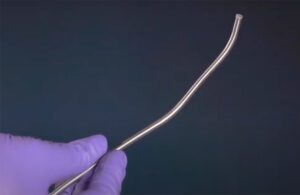How Penumbra’s smart-sucking algorithms and catheters speed up clot removals
Blood loss is a big problem when using aspiration catheters to remove blood clots from patients’ veins and arteries.
“You suck out the clot, you also suck out the blood,” said Sandra Lesenfants, president of the interventional business at Penumbra (NYSE:PEN).
Algorithms developed by Penumbra’s software team for the company’s continuous aspiration catheters are a key part of the solution, she said in an interview with Medical Design & Outsourcing.
Penumbra’s newest product, the Lightning Flash mechanical thrombectomy system, uses the company’s Lightning intelligent aspiration technology and adds a new dual clot detection feature.
“There is nothing equivalent on the market,” Lesenfants said. “The power of aspiration and therefore the speed of aspiration is the way we can quickly and completely now remove the clots in a very short timeframe.”
And there’s more in the pipeline as Alameda, California-based Penumbra aims to break $1 billion in annual revenue for the first time this year. The company plans to launch two other computer-aided aspiration products in 2023: the Lightning Bolt system for arterial clots in March and the Thunderbolt system for ischemic stroke in the second half of the year.
Penumbra’s Lightning Flash
Penumbra designed the Lightning Flash mechanical thrombectomy system to remove venous and pulmonary clots faster and more safely than previous devices.
Cleared by the FDA in late 2022, Lightning Flash builds on Penumbra’s previously launched computer-aided Lightning intelligent aspiration technology for differentiating between clot and blood. The latest version now has two algorithms — one for pressure and one for flow — for improved clot removal speed while still mitigating blood loss.
Penumbra’s proprietary software is embedded in the catheter and paired with dual pressure sensors to detect whether the catheter is sucking up clot as desired or whether it’s draining blood from the patient. The software controls a valve in the tubing for constant or intermittent suction.
“We measure the pressure and based on the pressure difference we can tell whether we are in clot or in blood,” Lesenfants said. “We have only one valve, which opens and closes something like 12 times in a second. It’s so rapid, it’s almost real-time. So we know immediately when we’re in clot, we know immediately when we are in blood, and therefore when we’re in clot, you can open [the valve].”
The system maintains constant suction when it senses the catheter is ingesting clot and automatically switches to intermittent aspiration when sensing open blood flow to minimize blood loss. The main challenges when developing the software were how to measure the pressure differential fast enough to approach real-time performance, as well as developing algorithms to maximize clot extraction while minimizing blood loss.
“It’s all about software. It’s a different world. … We think this is going to drive a new paradigm because we can take out more clot, we suck out less blood, and we can do it so much faster.”
How fast? Lesenfants offers a photo of a 4-ft-long blood clot — “I really like this one,” she said as she displayed it — removed from a deep vein thrombosis patient in six minutes. While the size of that clot might be an outlier, the removal time isn’t, with average Lightning Flash clot removal taking about seven minutes, she said.
“When you design or innovate a new technology, you put all these assumptions together, you see it working on the model, you have animal data, but it’s always hard to translate it to a clinical use and what it’s going to look like in patients. … The power of aspiration here, the speed, the ease of use, the safety profile and all these things are well beyond our expectations.”
Lightning Bolt and Thunderbolt
Penumbra designed Lightning Flash for veins and pulmonary arteries, while Lightning Bolt is meant for the unique properties of arterial clots. Clots on the arterial side are usually more fibrous and more difficult to ingest for removal.
Like Lightning Flash, Lightning Bolt also uses the intelligent aspiration software plus another algorithm that orchestrates modulating aspiration. The Lightning Bolt system has two valves: the first connects the catheter to the Penumbra Engine pump, and the second valve connects the catheter to a nonpressurized saline bag. Once the system senses clot engagement, the algorithms coordinate the rapid opening and closing of each valve to disrupt the friction between the clot and the catheter tip.
Penumbra expects the Lightning Bolt to win FDA clearance and launch by late March. That’s right around when Penumbra’s Thunderbolt mechanical thrombectomy system trial for strokes is scheduled to reach its primary completion date, with the study to be completed by June.
Like Lightning Bolt, the Thunderbolt system also uses the modulation algorithm to disrupt friction between the clot and catheter tip. The system uses Penumbra’s RED reperfusion catheters.
Penumbra’s high-performance aspiration catheters

Penumbra’s hypotube catheters are laser-cut for flexibility and maneuverability. [Image courtesy of Penumbra]Penumbra’s not relying on software alone. Its engineers designed low-profile, high-power aspiration catheters called Cat 7 and Cat 12 that were launched in 2021. The laser-cut, reinforced hypotube catheters have a soft, atraumatic tip to minimize damage to blood vessels.
“We love the aspiration profile because it is the most atraumatic, and you want to preserve the vessel and structure. That’s very important,” Lesenfants said.
The company’s MaxID (maximum inner diameter) technology gives the catheters a low profile to improve safety as well as trackability and torqueability, while offering an inner diameter size (or lumen) similar to large-bore catheters.

Penumbra’s MaxID technology maximizes the inner diameter and minimizers the outer diameter of its laser-cut hypotube catheters. [Image courtesy of Penumbra]Penumbra aimed to minimize the thickness of the catheter, delivering Cat 7 with an inner lumen of 2.1 mm and a 7 FR (2.33 mm) outer diameter. For comparison, the predecessor Cat 8 has an inner lumen of 2.2 mm and an 8 FR (2.7 mm) outer diameter.
Cat 7 also has what Penumbra said is a uniquely angled catheter tip for a 28.3 mm circumferential sweep to help remove clots stuck to the vessel wall.
The Lightning Bolt system uses a Cat 7 catheter. The Lightning Flash system uses a larger 16 FR catheter, but it is similarly a laser-cut hypotube with an atraumatic, angled tip and MaxID technology to improve aspiration and navigation.

Penumbra designed its catheters to balance strength, flexibility and size.
The Lightning Flash catheter’s flexible, low-profile design improves how well it can travel from one leg to the other in a deep vein thrombosis patient, or across the heart to treat pulmonary embolisms.
“The problem that we see with some of the current technologies is that these catheters are so big and so stiff, so rigid … so we designed a brand-new catheter that can track extremely well, cross the right side of the heart, go into the pulmonary artery,” Lesenfants said. “It’s so much easier, it’s softer, it’s more trackable.”
Article Source:MDO









